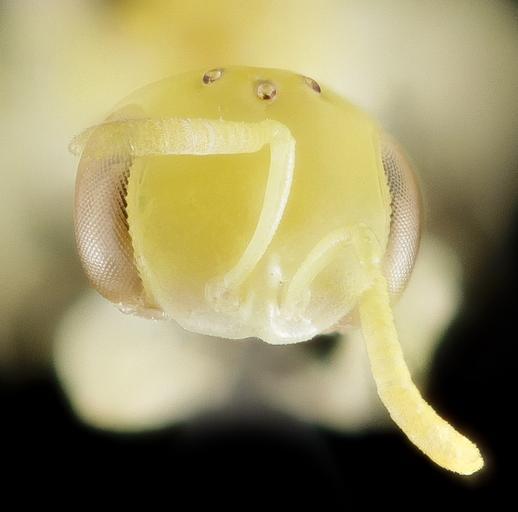MAKE A MEME
View Large Image

| View Original: | Brachyhesma_sulphurella,_australia,_face_2014-11-22-13.14.47_ZS_PMax.jpg (1089x1077) | |||
| Download: | Original | Medium | Small | Thumb |
| Courtesy of: | www.flickr.com | More Like This | ||
| Keywords: bee bees australia oz taxonomy:binomial=brachyhesma sulphurella taxonomy:binomial=brachyhesmasulphurella brachyhesma sulphurella brachyhesmasulphurella brachyhesma colletidae yellow light wing interference pattern winginterferencepattern wip minute minute bee minutebee макросъемка makro マクロ природа natur 自然 الطبيعة 大自然 naturaleza natura насекомое insekt الحشرة 昆蟲 insectos depth of field black background macro underwater water pastel organic pattern pattern texture serene Brachyhesma species, Australian Minute Bee, specimen collected by xxx in Australia Long: Until recently those who worked on the taxonomy of bees, or taxonomy in general for that matter, were men. Culturally that imbalance is now shifting, though we clearly still have a ways to go. Early female taxonomists were not unheard of however, and Australian Elizabeth Exley was a good example having described over 200 species of bees, working even after her retirement just for the joy of it. She described many of the 41 species of Minute Bees. Minutes Bees are just that, minute, some are as small as 2mm in length and all have a wan yellow base color to the integument of their exoskeleton . They are known to feed on the many species of plants in the Myrtle family in Australia, especially from Eucalyptus where hundreds of individuals can be obtained with a sweep net and an extremely long handle. These bees are a good example of the evolutionary radiation that occurred in the family Colletidae in Australia with bees ranging much larger than a honeybee down to less than 2 mm. ~~~~~~~~~~{{{{{{0}}}}}}~~~~~~~~~~ All photographs are public domain, feel free to download and use as you wish. Photography Information: Canon Mark II 5D, Zerene Stacker, Stackshot Sled, 65mm Canon MP-E 1-5X macro lens, Twin Macro Flash in Styrofoam Cooler, F5.0, ISO 100, Shutter Speed 200 Further in Summer than the Birds Pathetic from the Grass A minor Nation celebrates Its unobtrusive Mass. No Ordinance be seen So gradual the Grace A pensive Custom it becomes Enlarging Loneliness. Antiquest felt at Noon When August burning low Arise this spectral Canticle Repose to typify Remit as yet no Grace No Furrow on the Glow Yet a Druidic Difference Enhances Nature now -- Emily Dickinson Want some Useful Links to the Techniques We Use? Well now here you go Citizen: Basic USGSBIML set up: www.youtube.com/watch?v=S-_yvIsucOY USGSBIML Photoshopping Technique: Note that we now have added using the burn tool at 50% opacity set to shadows to clean up the halos that bleed into the black background from "hot" color sections of the picture. www.youtube.com/watch?v=Bdmx_8zqvN4 PDF of Basic USGSBIML Photography Set Up: ftp://ftpext.usgs.gov/pub/er/md/laurel/Droege/How%20to%20Take%20MacroPhotographs%20of%20Insects%20BIML%20Lab2.pdf Google Hangout Demonstration of Techniques: plus.google.com/events/c5569losvskrv2nu606ltof8odo or www.youtube.com/watch?v=4c15neFttoU Excellent Technical Form on Stacking: www.photomacrography.net/ Contact information: Sam Droege sdroege@usgs.gov 301 497 5840 Brachyhesma species, Australian Minute Bee, specimen collected by xxx in Australia Long: Until recently those who worked on the taxonomy of bees, or taxonomy in general for that matter, were men. Culturally that imbalance is now shifting, though we clearly still have a ways to go. Early female taxonomists were not unheard of however, and Australian Elizabeth Exley was a good example having described over 200 species of bees, working even after her retirement just for the joy of it. She described many of the 41 species of Minute Bees. Minutes Bees are just that, minute, some are as small as 2mm in length and all have a wan yellow base color to the integument of their exoskeleton . They are known to feed on the many species of plants in the Myrtle family in Australia, especially from Eucalyptus where hundreds of individuals can be obtained with a sweep net and an extremely long handle. These bees are a good example of the evolutionary radiation that occurred in the family Colletidae in Australia with bees ranging much larger than a honeybee down to less than 2 mm. ~~~~~~~~~~{{{{{{0}}}}}}~~~~~~~~~~ All photographs are public domain, feel free to download and use as you wish. Photography Information: Canon Mark II 5D, Zerene Stacker, Stackshot Sled, 65mm Canon MP-E 1-5X macro lens, Twin Macro Flash in Styrofoam Cooler, F5.0, ISO 100, Shutter Speed 200 Further in Summer than the Birds Pathetic from the Grass A minor Nation celebrates Its unobtrusive Mass. No Ordinance be seen So gradual the Grace A pensive Custom it becomes Enlarging Loneliness. Antiquest felt at Noon When August burning low Arise this spectral Canticle Repose to typify Remit as yet no Grace No Furrow on the Glow Yet a Druidic Difference Enhances Nature now -- Emily Dickinson Want some Useful Links to the Techniques We Use? Well now here you go Citizen: Basic USGSBIML set up: www.youtube.com/watch?v=S-_yvIsucOY USGSBIML Photoshopping Technique: Note that we now have added using the burn tool at 50% opacity set to shadows to clean up the halos that bleed into the black background from "hot" color sections of the picture. www.youtube.com/watch?v=Bdmx_8zqvN4 PDF of Basic USGSBIML Photography Set Up: ftp://ftpext.usgs.gov/pub/er/md/laurel/Droege/How%20to%20Take%20MacroPhotographs%20of%20Insects%20BIML%20Lab2.pdf Google Hangout Demonstration of Techniques: plus.google.com/events/c5569losvskrv2nu606ltof8odo or www.youtube.com/watch?v=4c15neFttoU Excellent Technical Form on Stacking: www.photomacrography.net/ Contact information: Sam Droege sdroege@usgs.gov 301 497 5840 | ||||